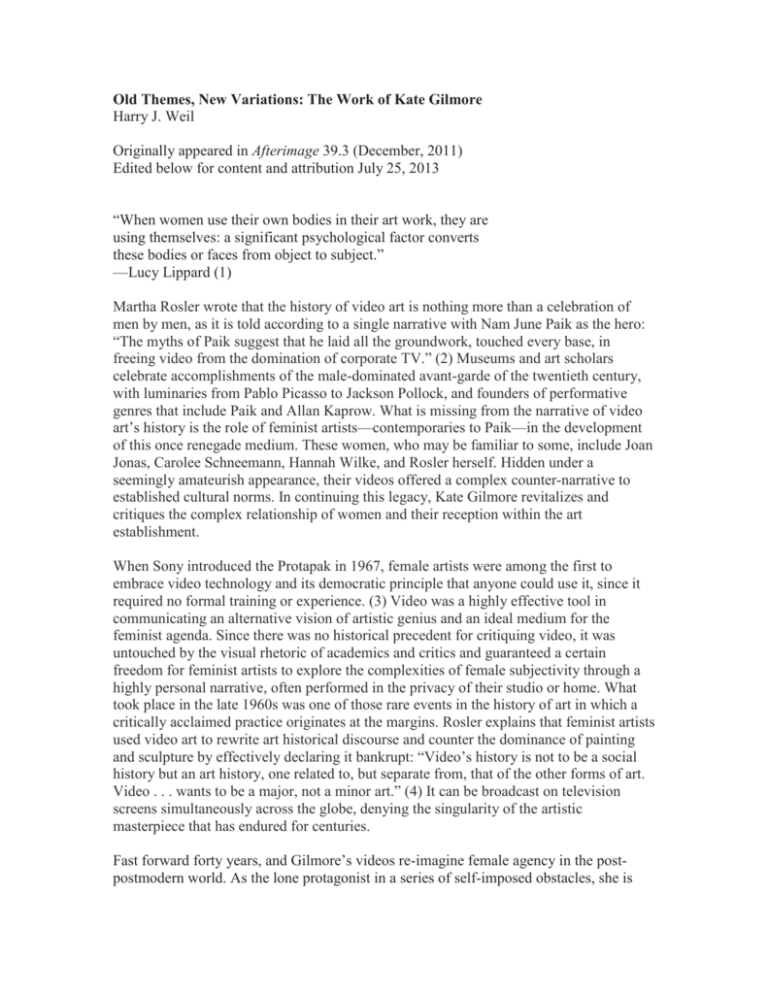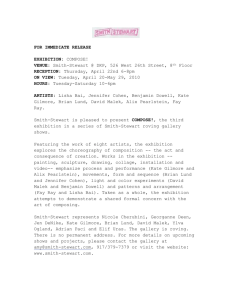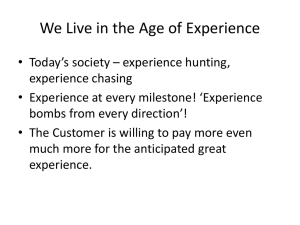Old Themes, New Variations: The Work of Kate Gilmore
advertisement

Old Themes, New Variations: The Work of Kate Gilmore Harry J. Weil Originally appeared in Afterimage 39.3 (December, 2011) Edited below for content and attribution July 25, 2013 “When women use their own bodies in their art work, they are using themselves: a significant psychological factor converts these bodies or faces from object to subject.” —Lucy Lippard (1) Martha Rosler wrote that the history of video art is nothing more than a celebration of men by men, as it is told according to a single narrative with Nam June Paik as the hero: “The myths of Paik suggest that he laid all the groundwork, touched every base, in freeing video from the domination of corporate TV.” (2) Museums and art scholars celebrate accomplishments of the male-dominated avant-garde of the twentieth century, with luminaries from Pablo Picasso to Jackson Pollock, and founders of performative genres that include Paik and Allan Kaprow. What is missing from the narrative of video art’s history is the role of feminist artists—contemporaries to Paik—in the development of this once renegade medium. These women, who may be familiar to some, include Joan Jonas, Carolee Schneemann, Hannah Wilke, and Rosler herself. Hidden under a seemingly amateurish appearance, their videos offered a complex counter-narrative to established cultural norms. In continuing this legacy, Kate Gilmore revitalizes and critiques the complex relationship of women and their reception within the art establishment. When Sony introduced the Protapak in 1967, female artists were among the first to embrace video technology and its democratic principle that anyone could use it, since it required no formal training or experience. (3) Video was a highly effective tool in communicating an alternative vision of artistic genius and an ideal medium for the feminist agenda. Since there was no historical precedent for critiquing video, it was untouched by the visual rhetoric of academics and critics and guaranteed a certain freedom for feminist artists to explore the complexities of female subjectivity through a highly personal narrative, often performed in the privacy of their studio or home. What took place in the late 1960s was one of those rare events in the history of art in which a critically acclaimed practice originates at the margins. Rosler explains that feminist artists used video art to rewrite art historical discourse and counter the dominance of painting and sculpture by effectively declaring it bankrupt: “Video’s history is not to be a social history but an art history, one related to, but separate from, that of the other forms of art. Video . . . wants to be a major, not a minor art.” (4) It can be broadcast on television screens simultaneously across the globe, denying the singularity of the artistic masterpiece that has endured for centuries. Fast forward forty years, and Gilmore’s videos re-imagine female agency in the postpostmodern world. As the lone protagonist in a series of self-imposed obstacles, she is always attired in a well-fitted dress with matching shoes that all too quickly become soiled with the dust, dirt, and paint splatters of her struggles. In So Much It Hurts (2006) Gilmore has a video camera attached to a pendulum-like device that continually hits her in the abdomen. We do not see her face in the vide0, just hear “ohh” and “ugh” as the camera collides with her. This is typical of her strenuous performances where physical comedy meets exercises in endurance. In Between a Hard Place (2008), Gilmore wears a black dress with matching gloves to tear through six layers of drywall, eventually ending in a room painted the same bright yellow color as her heels. As the video fades to black she turns, exhausted, to the camera and smirks. The uncompromising quality of this destruction denies the passivity of reclaiming vulva forms—think Georgia O’Keeffe or Judy Chicago—in favor of direct assault on the institutions of a male-dominated art world. Critics have drawn parallels between the endurance qualities of Gilmore’s work and Marina Abramović’s now famous masochistic performances that were highlighted in her 2010 “The Artist is Present” exhibition at the Museum of Modern Art in New York. Abramović sat in the atrium of the museum forthe run of the show and invited visitors to sit across from her in a quiet meditative state in a marathon test of stamina. Yet, as Randy Kennedy points out in the New York Times, Gilmore’s performances are not concerned with “the epic feat of public endurance.” (5) Rather, as the artist herself insists, labeling her as masochistic is the “biggest misconception.” (6) The exercises she creates for her videos are short-lived, and the goals she sets for herself, despite being difficult, are manageable. Part of what makes Gilmore’s ordeals so absorbing is the reality of the struggle involved. The videos are captured in real time without the use of stunt doubles or digital editing. Her actions before the camera are not such a strange activity when considered within the larger social move toward accessibility and self-promotion prompted by sites like Facebook and YouTube. In this virtual age, whole lives can be uploaded and distributed with the click of a mouse, and even reality television is dominated by monitoring the habits of minor celebrities. Gilmore screams “Look what I can do!”—the same attitude that has made careers for singers, dancers, and comedians who create videos for virtual audiences. But ask Gilmore to perform live and her answer would be “No.” She admits to being too conscious of viewer perceptions and her performances are not about what she can do, but what the female body can do. This is a marked difference from Abramović, who markets her performance as a personal struggle of survival embedded with social and cultural intensity. Gilmore’s recent performance Through the Claw took place in July 2011 at the opening of Pace Gallery’s “Soft Machines” exhibition in New York. This is possibly the artist’s messiest piece to date, as five women worked for nearly three hours tearing away at a 7,500 pound block of clay. The women were clad in bright yellow patterned dresses with heels. Using their bare hands, they tore at the block and hurled large clumps of clay at the gallery’s white walls, leaving brown imprints. Gilmore subverts the austere gallery standard: “I wanted to do something that would work well there, that would go against the space and use it in an interesting way.” (7) After all the clay was flung, the entire space was muddled with brown smears, which the artist agreed resembled the results of defecation. The celebratory act of tossing one’s waste could be seen in Freudian terms as a reversion back to the anal stage, when young children gain control of their anal sphincter and are thus able to give or withhold excrement, which is understood as a “gift.” In more economic terms, artists like Piero Manzoni, Paul McCarthy, and Andres Serrano have long foregrounded what art critic Donald Kuspit describes as “fashionable shit.” (8) Kuspit argues that in the current market, works of art are luxury items artists pitch to the elite as expensive gifts. These fashionable offerings of advanced capitalism amount to nothing more—both aesthetically and conceptually—than shit that has become a rationalized form of institutional critique. Shit is a cultural intervention that allows viewers to see a higher truth, and it “looms with a delusional bigness emblematic of America’s delusion of grandeur and physical bigness.” (9) Unlike McCarthy and Serrano, who mark their genius in creating shit, Gilmore’s performance is the destruction of shit. With this in mind, we can read the geometry of the block of clay as resembling the minimalist sculptures of Donald Judd and Tony Smith, who relied on industrial materials—namely metal—to create cubic and rectangular forms. Their work has become a fixture in nearly every modern and contemporary art museum and public space requiring austere decoration. Gilmore’s female performers tear apart the valued objects of the museum establishment, and dirty the clean white space that has harbored such objects for nearly half a century. Historically, women were not active in the creation of minimalist art; instead, artists like Eva Hesse and Lynda Benglis critiqued it by creating sculptures from materials with organic textures. Gilmore’s performance is a similar attack on high-modernist taste. Around the time Judd and Smith were at the height of their fame in 1975, Schneemann idealistically predicted that by the year 2000 women artists would no longer meet “the determined resistance and constant undermining” that she endured as a young art student.9 Nor would they “go into the ‘art world,’ gracing or disgracing a pervading stud club of artists, historians, teachers, museum directors, magazine editors, gallery dealers— all male, or committed to masculine preserves. All that is marvelously, already falling around our feet.” (10) When Schneemann began her career in the mid-’60s, the prevailing image of an artist was not only a male, but an action star, in the style of John Wayne who captured the popular imagination in western films slaughtering Indians to bring order to the frontier. In establishing its own rhetoric, the art market sanctified Jackson Pollock as the drunken cowboy who rebelled against the European standard to establish a truly American art form typified by his large splatter paintings. The art critic Harold Rosenberg described Pollock’s canvases as an arena in which to act. This image prevailed in Hans Namuth’s photographs and film of Pollock’s primitive painting technique, images with which Schneemann would have been all too familiar. (11) Schneemann’s relation to Pollock is at best complex, as seen in her video installation “Up To And Including Her Limits” (1973– 76). Six television screens cycle videos of the artist, clothed and unclothed, marking a white wall enclosure, sometimes while suspended from a tree surgeon’s harness. She draws with her eyes both open and shut, resulting in a cacophony of bright colors—reds, blues, and yellows—that mirror the crayon scribble drawings of a child. (12) These records of her movements are “marks referential to actions producing them—both visible and invisible, durable and nondurable.” (13) On the surface, Schneemann’s markings and gestures appear similar to Pollock’s, yet on closer inspection his are faster and more decisive where hers are more hesitant. In her writings about the performance, Schneemann described her intention to eliminate any element of theatricality and do away with: 1. Performance 2. A Fixed Audience 3. Rehearsals 4. Performers 5. Fixed Durations 6. Sequences 7. Conscious Intention 8. Improvisation 9. Technical Cues 10. A Central Metaphor or Theme (14) These concerns have much in common with Gilmore’s, whose interest in using video is meant to mediate the experience of a live performance. This acting out against theatricality subverts the burden of an audience to applaud or entertain. This is highlighted in Gilmore’s Blood from A Stone, for the Brooklyn Museum’s 2009 exhibition on contemporary feminist video art, “Reflections on the Electric Mirror.” The performance took place in a museum gallery during off-hours, and the remnants were left in place along with the video as a record of what transpired. In the video, Gilmore struggles to place heavy white plaster cubes atop a shelf covered in a thin layer of paint. As each cube is set down, paint splatters on the wall and drips off the shelf onto the floor. Like Schneemann, in this performance Gilmore does more than parody Abstract Expressionist or Minimalist technique— she also asks viewers to reflect on the absence of women in contributing to these revered canonical art styles. (15) New York Times art critic Ken Johnson asks to what end is this performance?: “Is she mocking art history’s love affair with masculine power and ambition? Or might she be satirizing old-school feminists’ grim determination to equal men in all endeavors?” As he suggests, the ambiguity of the performance is “a big part of its charm.” (16) Gilmore’s performances are not only relegated to the white walls of the gallery. In May 2010, Walk the Walk took place over seven days in Bryant Park in the heart of New York. Each day, from 8:30am to 6:30pm, seven women in bright yellow dresses walked back and forth atop an eight-foot-tall yellow platform. They looked straight ahead, seemingly unaware of the people below who snapped photos and gawked. (17) Their continuous pacing parodied the banality of the modern office space dominated by an endless maze of cubicles and stiff clothing. This banality was echoed in the simple yellow platform and the women’s endless strut that went nowhere, reflected the repetitious nature of meaningless office tasks. Gilmore reveals the structures that govern women within business and financial institutions, which are so often referenced as a “man’s world.” Marshall McLuhan gave artists a mythic power in being able to neutralize mass media through the use of film and video technologies. However, with the acceptance of such practices into the art establishment, artists began to be more concerned with production value than with political effect. Gilmore is an exception. She strays away from molding herself as a celebrity by steering the conversation toward the female body and its role in performing sexuality and gender. In 1997 Jan Avgikos wrote, “prior to Schneemann, the female body in art was mute and functioned almost exclusively as a mirror of masculine desire.” (18) Gilmore revitalizes this legacy in reinvesting in the female body as a site for social and cultural commentary and reassessing the erotic, the sacred, and the taboo of the female body; a potential place for beginning the conversation on women in the twentyfirst century. NOTES 1. Lucy Lippard, From Center: Feminist Essays on Women’s Art (New York: E.P. Dutto, 1976), 124. 2. Martha Rosler, “Video: Shedding the Utopian Movement” in Illuminating Video: An Essential Guide to Video Art, eds. Doug Hall and Sally Jo Fifer (New York: Aperture Foundation, 2005), 44. 3. Jane Harris, “Reflections on the Electronic Mirror: New Feminist Video.” TimeOut NY, http://www.timeout.com/newyork/art/reflections-on-the-electric-mirror-newfeminist-video. 4. Rosler, 44. 5. Randy Kennedy, “Pounding the Pavement on a Bryant Park Pedestal,” The New York Times, May 7, 2010, www.nytimes.com/2010/05/08/arts/design/08gilmore.html. 6. “The Artist’s Life: Kate Gilmore,” New York Foundation for the Arts, NYFA Current, www.nyfa.org/nyfa_current_detail.asp?id=17&fid=1&curid=886&print=true. 7. Kate Gilmore in Andrew Russeth, “Kate Gilmore Blankets Pace Gallery with 7,500 Pounds of Clay,” New York Observer, July 14, 2011, www.observer.com/2011/07/kate gilmore-blankets-pace-gallery-with-7200-pounds-of-clay. 8. Donald Kuspit, “Triumph of Shit,” artnet Magazine (May 2009), www.artnet.com/magazineus/features/kuspit/kuspit9-11-08 asp. 9. Ibid. 10. Carolee Schneemann, Imaging Her Erotics: Essays Interviews, Projects (Cambridge: MIT Press, 2003), 147. 11. Cliff Eyland. “Carolee Schneemann.” CAROLEE SCHNEEMANN: UP TO AND INCLUDING HER LIMITS. http://www.cliffeyland.com/schneemann01.html. 12. Ibid. 13. Schneemann, 158. 14. Carolee Schneemann, More Than Meat Joy (New York: McPherson & Company, 1979), 227. 15. Kimberly Lamm, “Reflections on the Electric Mirror: New Feminist Video Art,” Brooklyn Rail. http://www.brooklynrail.org/2009/07/artseen/reflections-on-the-electricmirror-new-feminist-video# 16. Ken Johnson, “SheTube: Female Voices on the Small Screen,”The New York Times, April 30, 2009, www.nytimes.com/2009/05/01/arts/design/01mirr.html. 17. Andrew Russeth. “Kate Gilmore.” Blouin Artinfo. http://www.blouinartinfo.com/contemporary-arts/article/34568-kate-gilmore. 18. Jan Avgikos as quoted in Amy Newman, “An Innovator Who Was the Eros of Her Own Art,” The New York Times, February 3, 2002, www.nytimes.com/2002/02/03/arts/art-architecture-an-innovator-who-wastheeros-of-her-own-art.html.








